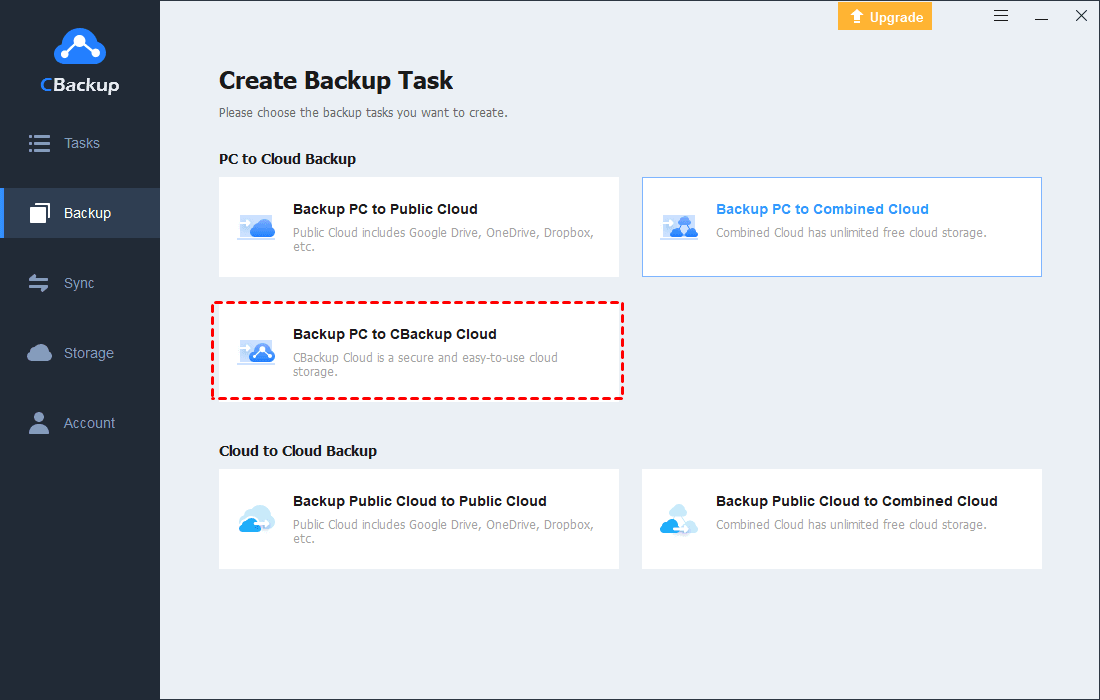How to Backup Data from Local Drive to CBackup Cloud?
CBackup desktop app can enable you to back up data from the local drive to CBackup Cloud to avoid the risk of data loss.
Preparations
To back up local data to CBackup Cloud via CBackup, you need to do:
- Register an account on CBackup’s official site, please click here to know more details.
- Download and install the CBackup desktop app program on your computer.
- Log in to your account on the desktop app program to create and manage the backup tasks.
Create a new backup task
We need to create a new task before making a backup, the operation of creating a new backup task is as follows.
Backup to CBackup Cloud
1. Run the desktop app program, then sign in to the account you created on the official site.
2. Click the Backup Now button under Tasks to create a backup task.
3. Select Backup PC to CBackup Cloud.
4. In the New Backup Task page, you can modify the default Task Name, and then check the local directories you want to back up.
5. Finally, Click the Start Backup button to run the backup task immediately, and you can also click the down-arrow button -> Later to add a task merely, then you can run it later.
- ★Tips:
- For the time being, we only support selecting local disks, external removable disks, Cloud drives, and USB as the source.
- Currently, NAS, network shares, and mapped disks are not supported as sources.
Back up to Combined Cloud
1. Run the desktop app program, then sign in to the account you created on the official site.
2. Click the Backup Now button to create a backup task.
3. Select Backup PC to Combined Cloud,
4. In the New Backup Task page, you can modify the default Task Name, and then check the local directories you want to back up.
5. Finally, Click the Start Backup button to run the backup task immediately, and you can also click the down-arrow button -> Later to add a task merely, then you can run it later.
About Combined Cloud, please click here to know more details.
Back up to Public Cloud
1. Run the desktop app program, then sign in to the account you created on the official site.
2. Click the Backup Now button to create a backup task.
3. Select Backup PC to Public Cloud,
4. In the New Backup Task page, you can modify the default Task Name, and then check the local directories you want to back up.
5. Next, please select a public cloud( such as Google Drive)
6. Finally, Click the Start Backup button to run the backup task immediately, and you can also click the down-arrow button -> Later to add a task merely, then you can run it later.
About Backup Settings
When you create the backup, you can click the Settings button to configure more settings for the backup task.
- Set a backup schedule for automated backup: set the task as a scheduled backup task, please click here to know more details.
-
Enable email notification for backup progress: a notification can be emailed containing the result of the backup. Click here to know more details.
-
Enable File Filter: set up file inclusion/exclusion from the source. Click here to know more details.
For the created old backup task, you can find its Backup Settings by clicking the three-dots button, if you'd like to run it again, please move the cursor on the task box then you'll see an arrow icon, please move the cursor over it and it will change to blue, next, please click it to run a backup again.
Restore
When your data is damaged or lost, you can restore the backup to get them back if you have created the backup for your data in advance. Please click here to know the restore steps.
About CBackup Cloud
CBackup Cloud is a cost-effective and secure online backup space especially for storing backups of your computers created by CBackup. CBackup Cloud servers are located in the United States and staffed every hour of every day of the year with top-notch security features.
CBackup Cloud offers 5GB free storage space to store backup data.
For a free account, the available CBackup Cloud storage space is 5GB, until it is used up; For a CBackup Basic account, the available CBackup Cloud storage space is 1000GB, and until it is used up; For a CBackup Premium account, the available CBackup Cloud storage space is 5000GB, until used up.
When the subscription of CBackup Cloud has expired, you can't continue to save the backup to CBackup Cloud. And, the backups created during the subscription period will be retained 90 days. So, you can restore them in 90 days. After 90 days, all backups will be deleted if you don't subscribe it.
- ★Tips:
- The first backup run after the backup task is created is a full backup. After the first full backup is run, subsequent backups will only back up the changed files.
- Backup image files will not be generated during CBackup backup. The backup files are all block files.
These block files will be stored in CBackup's directory under the directory specified by the user, and these block files will be stored in accordance with the user directory structure.
In addition, if the generated block file exceeds 32MB, CBackup will split the block file according to the standard of 32MB/block. Each block file is 32MB in size, and CBackup will create a folder for these split block files, and save all these segmented block files. If the generated block file does not exceed 32MB, CBackup will save the block file according to the corresponding directory structure.
Free Cloud Backup & Sync Service
Transfer files between cloud drives, combine cloud storage to gain free unlimited space
Secure & Free











